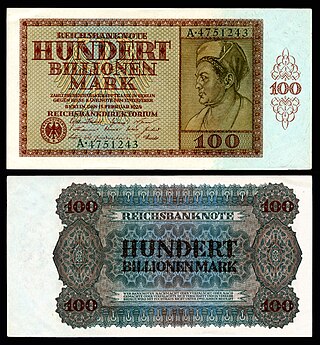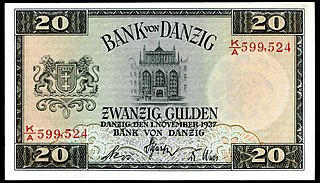
The Bank of Danzig (German : Bank von Danzig) was the central bank of the Free City of Danzig, established in 1924 and liquidated in the aftermath of the Danzig crisis in 1939.

The Bank of Danzig (German : Bank von Danzig) was the central bank of the Free City of Danzig, established in 1924 and liquidated in the aftermath of the Danzig crisis in 1939.

The Bank of Danzig was created under the conditions of the stabilization loan coordinated by the Economic and Financial Organization of the League of Nations in 1923–1024, based on the successful precedent of Austria a year earlier. It was established on 5 February 1924 with a capital of 7.5 million guilders, after the Reichsbank had ceased operations in the Free City on 31 December 1923. Its investors were private businesspeople and companies, including a consortium of Polish banks. [1] : 516 It soon started operations on 17 March 1924. It issued the Danzig gulden, which replaced the Reichsmark which had been devalued by hyperinflation.
The bank's first Governor was Konrad Meissner, then Walter Bredow, then Carl-Anton Schaefer from 1933. [2] : 176 The chairman of the supervisory board was Carl William Klawitter , and after the latter's death in 1929, Ernst Plagemann .
After the annexation of Danzig by the German Reich, the Reichsmark was introduced in Danzig and the Bank of Danzig was liquidated. The bank's gold holdings, which served as currency cover, were mainly stored at the Bank of England in London. With the Nazi invasion of Poland, these assets were confiscated by the British government and in 1976 handed over to Poland, which had annexed Danzig in 1945. [3] The bank's building again served as a branch of the Reichsbank from 1939 to 1945, when it was badly damaged by wartime bombing. After 1945 it has been used by the National Bank of Poland.

The mark was a currency or unit of account in many states. It is named for the mark unit of weight. The word mark comes from a merging of three Germanic words, Latinised in 9th-century post-classical Latin as marca, marcha, marha or marcus. It was a measure of weight mainly for gold and silver, commonly used throughout Europe and often equivalent to 8 troy ounces (250 g). Considerable variations, however, occurred throughout the Middle Ages.

Hjalmar Schacht was a German economist, banker, centre-right politician, and co-founder of the German Democratic Party. He served as the Currency Commissioner and President of the Reichsbank under the Weimar Republic. He was a fierce critic of his country's post-World War I reparations obligations. He was also central in helping create the group of German industrialists and landowners that pushed Hindenburg to appoint the first NSDAP-led government.

Hans Luther was a German politician and Chancellor of Germany for 482 days in 1925 to 1926. As Minister of Finance he helped stabilize the Mark during the hyperinflation of 1923. From 1930 to 1933, Luther was head of the Reichsbank and from 1933 to 1937 he served as German Ambassador to the United States.

The Free City of Danzig was a city-state under the protection and oversight of the League of Nations between 1920 and 1939, consisting of the Baltic Sea port of Danzig and nearly 200 other small localities in the surrounding areas. The polity was created on 15 November 1920 in accordance with the terms of Article 100 of the 1919 Treaty of Versailles after the end of World War I.

The Dawes Plan temporarily resolved the issue of the reparations that Germany owed to the Allies of World War I. Enacted in 1924, it ended the crisis in European diplomacy that occurred after French and Belgian troops occupied the Ruhr in response to Germany's failure to meet its reparations obligations.

The Young Plan was a 1929 attempt to settle issues surrounding the World War I reparations obligations that Germany owed under the terms of Treaty of Versailles. Developed to replace the 1924 Dawes Plan, the Young Plan was negotiated in Paris from February to June 1929 by a committee of international financial experts under the leadership of American businessman and economist Owen D. Young. Representatives of the affected governments then finalised and approved the plan at The Hague conference of 1929/30. Reparations were set at 36 billion Reichsmarks payable through 1988. Including interest, the total came to 112 billion Reichsmarks. The average annual payment was approximately two billion Reichsmarks. The plan came into effect on 17 May 1930, retroactive to 1 September 1929.

The Reichsmark was the currency of Germany from 1924 until 20 June 1948 in the Trizone, where it was replaced by the Deutsche Mark, and until 23 June 1948 in the Soviet occupation zone of Germany, where it was replaced by the East German mark. The Reichsmark was subdivided into 100 Reichspfennig. The Mark is an ancient Germanic weight measure, traditionally a half pound, later used for several coins; Reich comes from the official name for the German state from 1871 to 1945, Deutsches Reich.

The Papiermark was the German currency from 4 August 1914 when the link between the Goldmark and gold was abandoned, due to the outbreak of World War I. In particular, the Papiermark was the currency issued during the hyperinflation in Germany of 1922 and 1923.

The Reichsbank was the central bank of the German Reich from its establishment in 1876 until liquidation in 1945.

The Rentenmark was a currency issued on 15 October 1923 to stop the hyperinflation of 1922 and 1923 in Weimar Germany, after the previously used "paper" Mark had become almost worthless. It was subdivided into 100 Rentenpfennig and was replaced in 1924 by the Reichsmark.
The Oesterreichische Nationalbank (OeNB) is the central bank of Austria and, as such, an integral part of both the European System of Central Banks (ESCB) and the Eurozone. It started operations on 1 January 1923, replacing the Austro-Hungarian Bank of which it adopted the original name at its creation in 1816. It was liquidated following the Anschluss in March 1938, and re-established in July 1945.

The marka was the currency of the Kingdom of Poland and of the Republic of Poland between 1917 and 1924. It was subdivided into 100 Fenigów, like its German original after which it was modelled.

The gulden, divided into 100 Pfennige, was the currency of the Free City of Danzig from 1923 to 1939.

The Bank of Poland is the name of two former banks in Poland, each of which acted as a central bank. The first institution was founded by Prince Francis Xavier Drucki-Lubecki in 1828 in the Kingdom of Congress Poland. The second was established in 1924 under the Second Polish Republic by Prime Minister Władysław Grabski and was liquidated in 1952. Their legacy is continued by Poland's present central bank, the National Bank of Poland (NBP), founded in 1945.
Bank of Issue in Poland was a bank created by Nazi Germany in the General Government in 1940.

The building of the National Bank of Poland is a historical edifice, located at Jagiellońska street 8, in downtown Bydgoszcz, Poland.

The European banking crisis of 1931 was a major episode of financial instability that peaked with the collapse of several major banks in Austria and Germany, including Creditanstalt on 11 May 1931, Landesbank der Rheinprovinz on 11 July 1931, and Danat-Bank on 13 July 1931. It triggered the exit of Germany from the gold standard on 15 July 1931, followed by the UK on 19 September 1931, and extensive losses in the U.S. financial system that contributed to the Great Depression. The crisis has been widely associated with the subsequent rise of the Nazi Party in Germany and its eventual takeover of government in early 1933, as well as the emergence of Austrofascism in Austria and other authoritarian developments in Central Europe.
The Deutsche Golddiskontbank was a state-owned special bank founded in 1924 to promote German export industry by financing raw material imports. It was liquidated in 1945.

On the founding of the German Empire in 1871, trade and transport was hampered by the existence of eight different currency systems across the various member states of the Empire. There were eight state currencies whose coins included the Thaler, Vereinsthaler, Konventionsthaler, Kreuzer, Heller, Groschen, Silbergroschen, Neugroschen, Gulden, Konventionsgulden, Schilling, Mark, Pfennig, Neu-Pfennig, Franc, Centime, Bremen Goldthaler, Groten, Schwaren, Prussian or Graumann Reichsthaler, Kurantthaler and Friedrich d'Or, which were all based on different gold and silver standards, making trade more difficult.